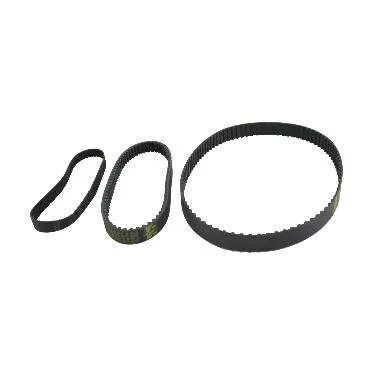A Critical Component for Precision Machinery
In modern mechanical engineering, the synchronous belt wheel plays a vital role in transferring power between rotating shafts in a reliable and efficient manner. These wheels, paired with synchronous belts, help in ensuring accurate motion control for machines, making them indispensable in various industries like automotive, manufacturing, and even robotics. When used in conjunction with synchronous belts, the synchronous belt wheel ensures minimal slippage and precise synchronization, enabling smooth and predictable performance of machines and systems.
One of the primary reasons why synchronous belt wheels are favored is their ability to maintain exact timing between the driving and driven components. Unlike other belt systems, such as V-belts, which may experience slippage, synchronous belt wheels ensure that power is transferred with high precision, making them perfect for applications that require timing accuracy.

Exploring the Different Synchronous Belt Types
When considering a synchronum balteum, it's essential to know the various synchronous belt types available in the market, as each is suited for specific applications. The most common synchronous belt types are the timing belts, which have teeth that mesh with corresponding grooves in the synchronous belt wheels. These belts come in different configurations based on the number of teeth per inch, the material they are made from, and the specific design required for the application.
Some synchronous belt types include:
Rubber Timing Belts: Made with a rubber compound, these belts are often reinforced with fibers like fiberglass or steel to enhance their strength and durability.
Polyurethane Timing Belts: Known for their high strength, wear resistance, and flexibility, these belts are used in industries that require precise control.
Silicone Timing Belts: These belts are designed for high-temperature applications and are often used in industries like food processing or pharmaceuticals.
Each of these synchronous belt types has a specific role in ensuring that the synchronous belt wheel operates at optimal efficiency, with each tooth of the belt precisely fitting into the grooves of the wheel for smooth power transfer.
Synchronous Round Belt: A Versatile Solution for Multiple Applications
A synchronous round belt offers unique advantages compared to traditional flat or V-shaped belts. Unlike other belts, which use teeth and grooves for meshing, the synchronous round belt features a smooth surface that provides superior flexibility and smooth operation. These belts are commonly used in applications requiring lightweight and compact solutions, such as in conveyor systems, small machinery, and packaging equipment.
The synchronous round belt is known for its high performance in conveying tasks, offering silent operation, minimal slippage, and precise positioning. They are typically used in smaller systems where space constraints and flexibility are important factors. With the ability to run on pulleys or rollers with specific diameters, synchronous round belts provide efficient motion transmission, ensuring a high degree of accuracy while also being easy to install and maintain.
What Is a Synchronous Belt? Understanding Its Function
A synchronum balteum is a type of mechanical power transmission device that transfers motion between rotating shafts with high precision. It is commonly used in systems where the accurate synchronization of two or more shafts is crucial, such as in timing mechanisms for engines, conveyor systems, and automation equipment.
The defining characteristic of a synchronum balteum is its toothed design, which meshes with the teeth of the corresponding synchronous belt wheel to ensure accurate and consistent motion. This design prevents slipping and maintains the timing between the components, unlike traditional V-belts. The teeth of the synchronum balteum interlock with grooves in the wheel, ensuring a tight grip and precise synchronization.
Additionally, synchronous belts are made from materials like rubber, polyurethane, and silicone, which provide strength, flexibility, and resistance to wear, ensuring a long service life in various demanding applications.
Choosing the Right Synchronous Belt and Wheel Combo for Your Application
When selecting the right synchronous belt wheel and synchronum balteum, it's important to consider several factors, such as load requirements, speed, precision, and environmental conditions. Different synchronous belt types will be more appropriate for specific tasks, and selecting the proper combination ensures efficiency, longevity, and optimal performance.
If you're looking for maximum precision and reliability, it’s crucial to work with experienced synchronous belt wheel and belt manufacturers who understand the nuances of design and material compatibility. Whether you need a standard or custom design, the right synchronous belt wheel and belt pairing will provide you with a powerful, durable solution for motion control.
Synchronous Belt Wheel FAQs
What is a synchronous belt wheel?
A synchronous belt wheel is a toothed wheel used in conjunction with a synchronum balteum. It helps transfer power and maintain precise timing between rotating shafts, offering superior efficiency and accuracy in motion control.
What are the different synchronous belt types?
The primary synchronous belt types include rubber timing belts, polyurethane timing belts, and silicone timing belts. Each type has its unique features, making them suitable for different industrial applications.
What is the difference between a synchronous round belt and a traditional belt?
Unlike traditional belts with grooves and teeth, a synchronous round belt is smooth and flexible. It provides superior flexibility, making it ideal for compact systems where space constraints and quiet operation are critical.
How does a synchronous belt work?
A synchronum balteum works by interlocking its teeth with corresponding grooves in the synchronous belt wheel, ensuring no slippage and maintaining accurate synchronization between rotating shafts.
How do I choose the right synchronous belt wheel and belt combo for my application?
To choose the right combination, consider factors such as load requirements, speed, precision, and environmental conditions. Consult with manufacturers who can guide you in selecting the best pairing for your specific needs.








